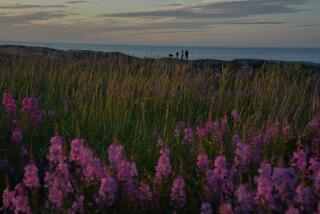Tourist Stop in Permafrost : Visitors Offered Look at Oil Fields, Dip in Frigid Alaska Waters
- Share via
DEADHORSE, Alaska — This rough-and-tumble oil camp on the permafrost is slowly emerging as a popular tourist stop with upwards of 6,000 visitors arriving every summer.
The weatherworn community is making a social and commercial shift from ragged and raw to accommodating and amiable.
A half-dozen companies offer bus and van tours of the adjacent 250-square-mile Prudhoe Bay field that produces about 20% of the nation’s domestic oil.
A quick dip in the Arctic Ocean is optional.
At least two of the community’s four major inns are aggressively seeking visitors over and above the usual contract workers and oil-industry representatives making sales or service calls.
For the North Star Inn, tourism is a hedge against the day when the 1.5-million-barrel-a-day flow down the trans-Alaska oil pipeline slows to a trickle. State projections indicate that Prudhoe Bay production will decline by 600,000 barrels a day between now and the end of the century.
“Service companies are pulling out of here all the time,” said Craig Clark, manager of the North Star Inn. “But we’re just like the oil companies. We’re always looking.”
NANA, the Kotzebue-based regional Native corporation, has gotten into the tour business in a big way at Deadhorse. Its Arctic Caribou Inn fills 25 to 35 rooms with people who ride the large Princess and Gray Line buses up the Dalton Highway four days a week in summer.
NANA also operates Tour Arctic Inc., whose Native guides meet airline passengers arriving from Fairbanks or Barrow.
People who sign up for the $60 tour are given a four-hour orientation ride around the oil patch and then they can buy tickets for an all-you-can-eat, North Slope-style dinner before catching evening flights out of town.
“It’s not only all you can eat, it’s the best you can eat,” said Paul Goodwin, who manages the Arctic Caribou Inn. “That’s part of the tradition of this oil field.”
BP Exploration (Alaska) and Arco Alaska, which run the field, cooperate in varying degrees with the tour companies. The guides must provide the name, address and an ID number for each of their visitors before they’re allowed through the checkpoints.
“The arrangement that has been worked out with the tour operators is one that allows for safe visitation,” said Ronnie Chappell, an Arco spokesman in Anchorage. “We don’t allow unescorted individuals roaming around the field.”
Paul Laird of BP said too many people have misconceptions about oil production on the North Slope.
“We think the more people who see and are familiar with our facilities, the better,” he said.
But Deadhorse still has some grooming to do before it can fully satisfy the needs of the casual traveler.
Drivers of motor homes, for example, often wait more than an hour for someone to top off their tanks at the only gas station in town that sells to retail customers. And then it’s a cash-only transaction at $1.77 a gallon, unless they’ve arranged for a computerized credit card from Petro Star or one of the nearby inns.
People accustomed to four-star hotel rooms must make do with bathrooms down the hall, barracks style.
Photographers have to contend with balky and often mud-covered bus windows as they point their cameras at caribou, waterfowl and the 10-story-high modules rising from pilings on gravel pads.
But visitors say that’s part of the mystique surrounding the treeless and transient community some 250 miles above the Arctic Circle.
BP averages around 2,000 people a year for North Slope visits, Laird said. Arco, which offers coffee, cookies and a hard sell about opening the nearby Arctic National Wildlife Refuge to oil and gas exploration, tallies 4,000 to 6,000, Chappell said.
Visitors run the gamut from retirees up for a look at the wildlife to oil-platform workers on a busman’s holiday from the Gulf of Mexico. Tourists also arrive from Germany, Japan and Australia.
On a foggy day in mid-June, seven visitors were being entertained by two Tour Arctic guides aboard a white school bus as it bounced its way down rutted and muddy oil-field roads.
Nina Dozette, a 27-year-old Athabascan Indian from Ruby, talked about oil production, pipeline output and the weather.
Martin Woods, an Inupiat Eskimo from Kotzebue, used a headset-mounted microphone to describe the differences between pingoes and tussocks, reindeer and caribou.
It’s a language and a landscape exclusive to the Arctic.
“It’s fascinating to compare this operation with where I work in the Gulf,” said oil field employee Karen White of Baton Rouge, La. “I’d like to come up here and work for awhile.”
Some people return year after year for another look at the wildlife or the changing oil field.
“They also can’t get enough of the Beaufort Sea,” said Dozette, a senior at the University of Alaska in Anchorage, who plans to teach in a small village like the one where she grew up.
“I’ve had seven people--six on one bus--go into the water so far this year. There’s ice still floating on it. I tell them, ‘If you have a high heart-attack potential, please . . .’ ”
More to Read
Sign up for The Wild
We’ll help you find the best places to hike, bike and run, as well as the perfect silent spots for meditation and yoga.
You may occasionally receive promotional content from the Los Angeles Times.






